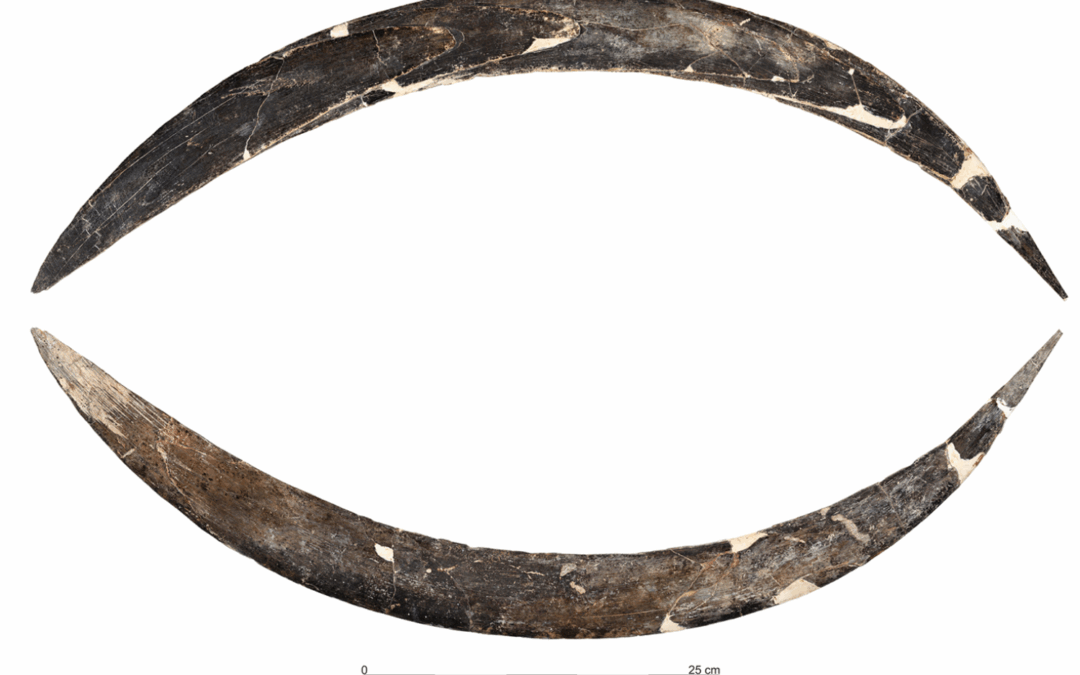Keep our news free from ads and paywalls by making a donation to support our work!

Notes from Poland is run by a small editorial team and is published by an independent, non-profit foundation that is funded through donations from our readers. We cannot do what we do without your support.
The world’s oldest known boomerang, which was found in a cave in Poland, is even older than previously thought. It was carved from a mammoth tusk around 40,000 years ago, according to a newly published scientific paper.
Although boomerangs are most commonly associated with Aboriginal Australians (from whom the word itself is borrowed), the term can in fact refer to various kinds of throwing sticks, often used for hunting, and which do not have to be designed to return to the user when thrown.
The 72-centimetre-long artefact found during archaeological research in Obłazowa cave in southern Poland is one such item, with experiments based on its size and shape showing that it was a so-called “non-returning boomerang”.
Słynny #bumerang z Jaskini Obłazowej (Małopolska) powstał nawet 42 tys. lat temu – dużo wcześniej, niż sądzono. Może być pierwszym na ziemiach polskich zapisem kultury duchowej #Homosapiens – mówi #archeolog prof. Paweł Valde-Nowak @JagiellonskiUnihttps://t.co/AEAdq6teBj
— Nauka w Polsce (@naukawpolsce) June 30, 2025
When the object was first found in 1985 by Paweł Valde-Nowak, a professor of archaeology at the Jagiellonian University in Kraków, it was believed to be from the Pavlovian culture, which existed in the area around 30,000-23,000 years ago.
That already made it the world’s oldest known boomerang – a claim even acknowledged by Guinness World Records. However, a new study by a group of international scholars published in the PLOS One scientific journal has found the item to be even older, dating back between 42,000 and 39,000 years.
The researchers note that this was a period when humans began to “demonstrate an enhanced symbolic capacity, [including] expanding artistic manifestations”.
They say that the boomerang from the Obłazowa cave is “a particularly remarkable example” of the developing “technical skills and cognitive advancements of Homo sapiens in crafting these complex tools”.
Valde-Nowak, who participated in the new research, told science news service Nauka w Polsce that the older dating of the boomerang and items found around it will necessitate a “huge interpretative change”.
This was a “moment of an explosion in the spiritual culture of humans”, who “began to experience deeply, to react and externalise their feelings”. He noted that examples of this have been found in France, Spain and Germany, but “the Obłazowa cave is the only evidence of such behaviour in Polish lands at that time”.
Until now, it was believed that humans appeared only 35,000 years ago in the part of Europe where present-day Poland is located, which meant that after the extinction of Neanderthals, the region was supposed to have been uninhabited for millennia.
The new dating of the boomerang presents fresh evidence of the lasting presence of Homo sapiens in this part of the world as early as around 42,000 years ago.
An item discovered by chance on a farm in Poland has been confirmed as a 6,000-year-old figurine depicting a woman.
It has been nicknamed the “Venus of Kołobrzeg” due to its similarity to other ancient statuettes symbolising femininity and fertility https://t.co/WJTaRjyD3A
— Notes from Poland 🇵🇱 (@notesfrompoland) June 18, 2025
For now, however, the scientists cannot say for certain whether the boomerang had a symbolic and spiritual meaning and is evidence of early human rituals, or whether it was more of a utilitarian item.
Valde-Nowak notes that the item was placed in an exposed place, surrounded by boulders weighing over 60 kilograms that someone had rolled into the cave. Around it were the oldest human bone found in Polish lands and a number of valuable objects. The entire area was covered with red ochre dust.
“These are all signals that make us think about the boomerang more in terms of ritual than everyday life,” Valde-Nowak explained.
On the other hand, boomerangs that do not return to the thrower – like the one from the Obłazowa cave – are known to have been used as combat tools, for butchering carcasses, digging wells or kitchen pits, scraping hot ashes from roasted meat, or as part of percussion instruments.
A mammoth tusk and pelvis fragment dating back to the Ice Age have been discovered during archaeological works in Poland.
The remains were found during excavations related to the construction of the S17 expressway.https://t.co/hzq4nHVm05
— Notes from Poland 🇵🇱 (@notesfrompoland) June 17, 2025

Notes from Poland is run by a small editorial team and published by an independent, non-profit foundation that is funded through donations from our readers. We cannot do what we do without your support.
Main image credit: “Boomerang and bones: Refining the chronology of the Early Upper Paleolithic at Obłazowa Cave, Poland”, PLOS One

Agata Pyka is a former assistant editor at Notes from Poland. She specialises in Central and Eastern European affairs, cybersecurity, and investigative reporting. She holds a master’s degree in political communication from the University of Amsterdam, and her work has appeared in Euractiv, the Balkan Investigative Reporting Network (BIRN), and The European Correspondent, among others.



















